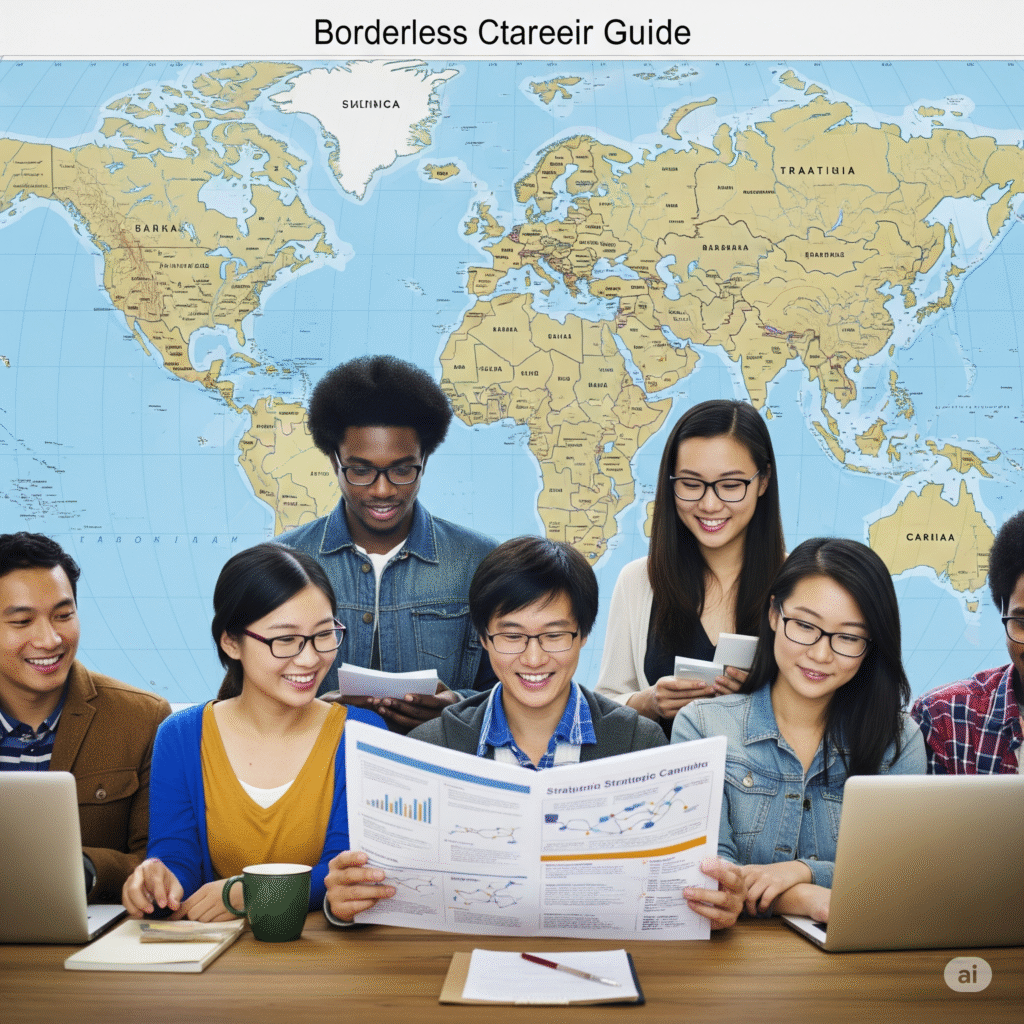Introduction: The Global Dream vs. The Global Reality
Have you ever stared at your laptop screen, bouncing between LinkedIn and countless job boards, only to receive your 47th rejection email this month? Perhaps it’s the same story, different words, every single time: We appreciate your impressive international education, but we’re looking for someone with more local experience.
If you’re three months out from graduation, with a student visa expiration date feeling like a ticking time bomb, and you’re wondering if leaving home, studying abroad, and building a life in a new country was a massive mistake — then you are not alone.
But here’s the electrifying truth: Today’s interconnected world truly opens doors to unprecedented opportunities for students. Your international education is far more than just a degree; it’s a launchpad for exciting global job opportunities, personal growth, and a powerful edge in today’s competitive job market. However, building an international career rarely happens by accident. It demands deliberate strategy, not just hopeful wishes or an impressive transcript.
This guide is your action-packed blueprint to unlock those boundless opportunities. We’re here to share the real, no-fluff strategies that empower you to leverage your international education and navigate the unwritten rules of global career building. Get ready to transform your international education into a thriving global career and embrace a professional journey without boundaries.
Section 1: The Foundation – Strategic Positioning Before (or Immediately After) Graduation
Even if you’ve already graduated, don’t worry. You can absolutely retroactively build these crucial elements.
1.1 Crafting Your Unique International Identity: Becoming Indispensable
The biggest mistake? Trying to be a vague generalist with international experience. That’s simply too indistinct in a fiercely competitive job market.
- Specificity Over Generalization: Your career truly takes off when you become the [specific professional skill] person who has the unique advantage of understanding [specific international perspective]. For example, don’t just be an international business graduate; be the digital marketing specialist who understands both Eastern European and Western markets. This specificity makes you memorable and immensely valuable.
- The Overlooked Power of Academic Projects: Believe it or not, your academic work can be career gold if positioned correctly. Reframe your major academic projects as if they were professional consulting assignments, emphasizing their practical business value, not just academic requirements. A thesis on environmental regulations, for instance, can be brilliantly reframed as regulatory compliance research for companies operating across EU-Asian markets.
1.2 The Power of Proactive Networking: Beyond Cold Applications
Cold-applying to jobs, especially with an international background, is brutally ineffective. You’ll send hundreds with a minuscule response rate.
- The Ongoing Conversation Strategy: This is your secret weapon. Instead of asking for jobs, start reaching out to professionals with specific, thoughtful questions about their work. Follow up every few weeks with relevant insights. Why? Because when a position opens up, you’re already a familiar name in their inbox — not just another random foreign applicant.
- Leverage Global Networks: Your time abroad gave you access to global networks. Connect with professors, mentors, classmates, and professionals from every corner of the world. These connections are golden tickets to job opportunities, collaborative projects, and even entrepreneurial ventures. Stay connected through alumni networks, LinkedIn, or academic associations. Participate in global conferences, webinars, or regional meetups to stay visible.
Section 2: The Bridge Period — Critical First Years Post-Graduation
The first 1–3 years after graduation are your bridge period — where you transition from international student to global professional. This is where many get stuck, but you won’t.
2.1 The Local Experience Catch-22 and How to Break It
You need local experience to get hired, but you can’t get local experience without getting hired. It’s a wall, but you can break through it.
- The Project-to-Permanent Strategy: Short-term projects and contract work have lower hiring barriers but can lead to permanent roles. My mentee Priya couldn’t get interviews for full-time jobs, so she took a 6-month contract that transitioned into a full-time offer within 4 months.
- The Strategic Volunteer Approach: Volunteer for tasks that build measurable professional skills. Manage social media, lead a small project — anything that gives you clear achievements to discuss in interviews and builds local connections.
- The Home Country Advantage Technique: Work for a company from your home country that has an office in your host country. They often value your cultural understanding and language skills, offering the perfect bridge to gain local experience.
2.2 The International Value Proposition Framework
Stop seeing your international background as a challenge. Build your professional identity around it.
- Cross-Cultural Translation Skills: Highlight how you bridge communication gaps between markets. Did you adapt messaging for diverse regions? That’s your unique edge.
- Global Perspective on Local Problems: Research your target companies’ challenges and propose how international approaches can help. This positions you as a valuable problem-solver with an outside-the-box view.
- Adaptive Resilience: Share stories of flexibility, problem-solving, and communication across cultures. These traits are immensely valuable. My mentee Hiroshi went from zero callbacks to three job offers in five weeks by using this approach.
Section 3: Mid-Career International Mobility — Years 3–7
Once you’ve built that first foothold, the next challenge is maintaining your international flexibility and momentum.
3.1 The Portable Skills Portfolio Strategy
Start building skills that are valuable across borders.
- Focus on capabilities that are in demand globally, not tied to specific countries, and can be easily demonstrated. Digital marketing analytics, e-commerce strategy, and UX design are great examples. My mentee Rafael shifted from local accounting to financial analysis and boosted his international options.
3.2 The Internal Transfer Hack
Internal transfers within global companies are one of the most reliable paths to work abroad.
- Build relationships with teams in your target office. Collaborate on cross-office projects. When a business need arises, you’re already the obvious candidate. Bonus: internal transfers often have fewer visa complications.
3.3 The Global Project Catalyst Technique
Even without relocating immediately, seek international experience through cross-border work.
- Volunteer for international initiatives, even if it means more work. Leading or supporting global projects boosts your visibility and prepares you for future mobility. Carlos used this method and became his company’s go-to person for Latin American markets — eventually securing relocation.
The International Insurance Policy: Financial Strategies for Global Careers
Financial planning gives you the flexibility to pursue international careers with less stress.
4.1 The Six-Month Runway Rule
Keep at least six months of living expenses in accessible savings. This allows you to decline bad-fit roles and wait for the right international opportunity.
4.2 The Multi-Currency Approach
Maintain accounts in multiple currencies like USD, EUR, and your home currency. This saves on conversion fees and provides flexibility during sudden transitions. Sanjay’s multi-currency accounts helped him relocate smoothly and cost-effectively.
4.3 The Digital Nomad Backup Plan
Develop location-independent skills and clients as a backup. In case of sudden visa or job changes, this gives you income and ongoing professional growth.
The Reality of Relationships: Personal Life as a Global Professional
An international career impacts your personal life — sometimes in unexpected ways.
5.1 The Long-Distance Support Network
Stay close to family and friends through regular video calls, voice notes, and planned catch-ups. Anya, one of my mentees, beat loneliness by blending local friendships with long-distance rituals.
5.2 The Cultural Home Concept
Build your identity through meaningful rituals and habits — cooking traditional meals, celebrating home-country holidays, or engaging with local communities.
5.3 The Both/And Approach to Relationships
You don’t have to choose between love and career. Long-distance or alternating locations is tough, but doable with intentional planning. Miguel and Sophie made it work for three years and now thrive in the same city.
The Practical Toolkit: Documents, Visas, and Logistics
Practical prep makes global careers smoother.
6.1 The Always Ready Document Portfolio
Keep these updated and ready at all times:
- Passport (minimum 18 months validity)
- Degree certificates and translations
- Reference letters
- Authenticated identity docs
- Updated CV (in multiple formats)
- Professional photo and bio
6.2 The Visa Chess Game
Always think a few moves ahead with visas. For example, a part-time work permit can lead to a work visa, which may open up residency. Research visa pathways in your target countries.
6.3 The Somewhere Permanent Home Base
Even if you’re mobile, a permanent address helps with:
- Receiving official mail
- Banking continuity
- Tax clarity
- A safety fallback if needed
From Student to Global Leader: The Long Game
Here’s how successful international professionals reach the top.
7.1 The Rare Skills Combination Strategy
Don’t just be good at one thing — be great at a rare combination. My mentor paired public health, data science, and Arabic fluency — now she chooses which projects to work on.
7.2 The Selective Specialization Approach
Become the go-to expert in a specific area with global relevance. My colleague in renewable energy policy across emerging markets is now in constant demand worldwide.
7.3 The Global Problems, Local Solutions Framework
The most powerful careers solve big global issues with local insight. Chitra used her Indian and Nordic experience to create hybrid transportation solutions — and positioned herself as a sought-after expert.
Final Thoughts: The Reality Behind the Instagram Posts
International careers aren’t always glamorous. There are trade-offs, visa headaches, cultural missteps, and moments of deep doubt.
But the rewards — global relationships, career freedom, and deep personal growth — are incredible. Behind every polished LinkedIn success story is someone who once doubted themselves, just like you.
You absolutely can do this. With strategy, support, and resilience, you’ll build a career that reflects your bold ambitions and global spirit.
Where are you in your journey right now? What specific challenges are you facing? Share your thoughts and let’s tackle them together.









